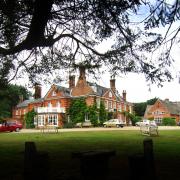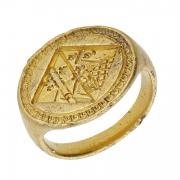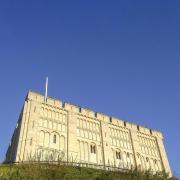‘I hear the grunts of musclemen exercising and jerking those heavy weights around...If there happens to be a lazy fellow content with a simple massage I hear the slap of hand on shoulder... a ball-player comes up and starts calling out his score...and a fellow who likes the sound of his own voice in the bath, plus those who plunge into the pool with a huge splash of water...add the mingled cries of the drink peddler and the sellers of sausages, pastries...’
Today the summer silence at Caistor St Edmund is pierced by the rippling song of a skylark, way overhead, and the occasional bleat of sheep sheltering from the sun in the shadow of ancient walls.
But almost 2,000 years ago crowds would have been thronging to the baths here. Alexandra Atherton, of the Caistor Roman Project, is summoning the clamour of Roman baths with the words of Roman writer Seneca.

‘People went to the bath house to get clean, but also to hear the news and gossip, have a chat,’ said Alex, one of the volunteers who lead free guided tours around the intriguing site through the summer.
Every year there are new facts to learn, new information to impart, as each August an archeological dig unearths more information about this remarkable place.
Almost a century ago a pilot watched a ghost town emerge from drought-parched fields three miles south of Norwich. Beneath him he saw the streets and buildings of ancient Venta Icenorum (or marketplace of the Iceni people) traced across the grass inside the ancient ramparts of Caistor St Edmund.
The existence of a Roman settlement here had been known for centuries – but its scale, and its street plan with temples, bath houses and government buildings, was hidden for 1,600 years.
Today the site is still giving up its secrets.
It is one of just three major Roman towns in the whole of Britain not obscured by more modern settlements, leaving the administrative centre for Norfolk, north Suffolk and east Cambridgeshire, abandoned and hidden in plain sight.

It is owned and protected by the Norfolk Archaeological Trust and every August the volunteers of Caistor Roman Project take part in an archaeological dig, led by William Bowden of the University of Nottingham. This year’s dig, in the last two weeks of August, will be on private land but it is hoped to open the site to visitors where possible.
Caistor Roman Project began with a quest to determine the extent of Roman settlement in the area. Villagers volunteered to have test pits dug in their gardens which revealed Roman remains far beyond the walled town. Ever since each annual dig has brought more revelations including the site of the second largest Romano-Celtic temple known in Britain and, last year, an underground aqueduct which would have carried clean spring water into the town.
There are now more than 100 members of the community archaeology group and as well as taking part in the digs they process finds, lead tours, carry out research and work with local schools and groups.
Mike Pinner, chairman of the trustees, said: ‘We have members from all walks of life (many of whom had no archaeological experience when they joined) all working to high standards to continue bringing the history of the area to life. We are very grateful for the support of High Ash Farm, Caistor Hall Hotel and the local community.’
The first Roman town, surrounded by triple ditches built in around 100AD, was far bigger than the area contained within the third century ramparts, stretching across fields to the south, where an ampitheatre has been discovered, and over into the grounds of Caistor Hall Hotel.
Intriguing traces of the people who lived here almost 2,000 years ago include a lead ‘curse tablet’ found beside the river. Enraged by the theft of treasured possessions, the writer asked Neptune, god of the sea, to punish the offender – and promised to reward the deity with a pair of leggings. It is among the Caistor treasures at Norwich Castle Museum.
As the Roman empire collapsed, Venta Icenorum, meaning gradually fell into disrepair. Walls and buildings collapsed, or were quarried for new houses nearby, and perhaps even taken downstream for Norwich’s medieval walls.
But the ancient landscape comes alive again each summer as the volunteers of the Caistor Roman Project dig into its history and add to our understanding of this intriguing place.
Enjoy a free tour of Roman Caistor St Edmund at 2pm every Sunday until the end of September, plus 2pm on Wednesdays until the end of August.
For more information about joining or sponsoring Caistor Roman Project visit caistorromanproject.org



























